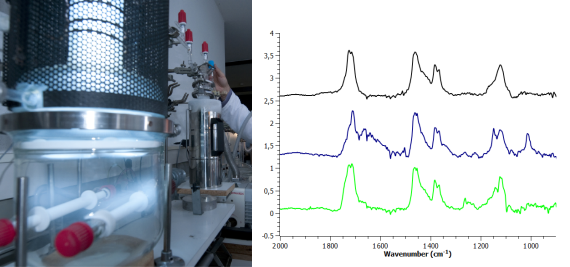Polymérisation plasma et revêtements fonctionnels
Engineering functional plasma polymers
Aissam Airoudj, Florence Bally-Le Gall, Philippe Kunemann, Jamerson Oliveira, Vincent Roucoules
Contact : florence.bally-le-gall@uha.fr and vincent.roucoules@uha.fr
Plasma-assisted polymerization is a green process for surface functionalization that does not require the use of any solvent. The synthesized polymer coatings (typically having a thickness of a hundred of nanometers) can be deposited on materials of various natures (composition and geometry) since the deposition occurs at room temperature and in vapor phase. In addition, the adhesion of these coatings on their substrate is usually good since it is based on covalent bonds at the substrate/thin film interface and their cohesion is ensured by a crosslinked structure, leading to relatively stable and durable coatings. We exploit this surface functionalization technique to engineer on-demand functional polymer coatings to target high added-value properties (antibacterial, superhydrophobic, hydrogel-like, among others) and we investigate the relation between the thin film structure and its behavior in its environment (being gaseous, liquid, solid or biological).

Publications
Plasma polymerization in the design of new materials : looking through the lens of maleic anhydride plasma polymers,
Materials Today Chemistry 2022, 23, 100646. DOI : 10.1016/j.mtchem.2021.100646
VEUILLET Mathieu, PLOUX Lydie, AIROUDJ Aissam, GOURBEYRE Yannick, GAUDICHET-MAURIN Emmanuelle, ROUCOULES Vincent.
Macroscopic control of DMAHEMA and HEMA plasma polymerization to tune the surface mechanical properties of hydrogel-like coatings,
Plasma Processes and Polymers 2017, 14(10), 1600215. DOI : 10.1002/ppap.201600215
BALLY-LE GALL Florence, MOKHTER Akmali, LAKARD Sophie, WOLAK Séverine, KUNEMANN Philippe, FIOUX Philippe, AIROUDJ Aissam, EL YAKHLIFI Salima, MAGNENET Claire, LAKARD Boris, ROUCOULES Vincent.
Poly(allylamine) plasma polymer coatings for an efficient retention of Ni(II) ions by ultrafiltration membranes,
Plasma Processes and Polymers 2019, 16(3), e1800134. DOI : 10.1002/ppap.201800134
JEBALI Syrine, AIROUDJ Aissam, FERREIRA Isabelle, HEGEMANN Dirk, ROUCOULES Vincent, BALLY-LE GALL Florence.
Unique combination of spatial and temporal control of maleic anhydride plasma polymerization,
Plasma Processes and Polymers 2021, 18(8), e2000244. DOI : 10.1002/ppap.202000244
Mechanisms of formation of plasma polymers and nanostructuration
Aissam Airoudj, Florence Bally-Le Gall, Jamerson Oliveira, Vincent Roucoules
Contact : jamerson.carneiro-de-oliveira@uha.fr , vincent.roucoules@uha.fr
A plasma produces a wide range of species (molecules, atoms, radicals) in many energetic states (ionized, excited, metastable and fundamental states). These precursors can react or self-assemble to form solid polymeric objects with specific properties. We aim to understand and control the mechanisms related to the morphogenesis of complex structures generated during plasma polymerization. The challenge comes from the difficulty in identifying the predominant species leading to the formation of organized units and from multi-scale dimensions of these systems for which chemical and physical phenomena can occur at different spatial and temporal scales.

Publications
BRIOUDE Michel M, LABORIE Marie‐Pierre, HAIDARA Hamidou, ROUCOULES Vincent. Understanding the Morphogenesis of Nanostructures in Maleic Anhydride Plasma Polymer Films via Growth Kinetics and Chemical Force Titration, Plasma Processes and Polymers 2015, 12(11), 1220-1230. DOI : 10.1002/ppap.201400224
BRIOUDE Michel M, ROUCOULES Vincent, HAIDARA Hamidou, VONNA Laurent, LABORIE Marie-Pierre. Role of cellulose nanocrystals on the microstructure of maleic anhydride plasma polymer thin films, ACS Applied Materials & Interfaces 2015, 7(25), 14079-14088. DOI : 10.1021/acsami.5b03302
LE Nghia H., BONNE Magali, AIROUDJ Aissam, FIOUX Philippe, BOUBON Rémi, REBISCOUL Diane, BALLY-LE GALL Florence, LEBEAU Bénédicte, ROUCOULES Vincent. When chemistry of the substrate drastically controls morphogenesis of plasma polymer thin films, Plasma Processes and Polymers 2020, e2000183.DOI : 10.1002/ppap.202000183
JEBALI Syrine, CARNEIRO DE OLIVEIRA Jamerson, AIROUDJ Aissam, JOSIEN Ludovic, FIOUX Philippe, FERREIRA Isabelle, ROUCOULES Vincent, BALLY-LE GALL Florence. Thin films deposition versus nanoparticles formation : How can the desired polymer coating be obtained ?, Plasma Processes and Polymers 2022, 19(1), 2100091. DOI : 10.1002/ppap.202100091
Design of superhydrophobic plasma polymers
Aissam Airoudj, Florence Bally-Le Gall, Philippe Kunemann, Jamerson Oliveira, Vincent Roucoules
Contact : florence.bally-le-gall@uha.fr and aissam.airoudj@uha.fr
The fabrication of durable superhydrophobic coatings is a challenge for many applications (textile, electronics…). Controlling the plasma species formed, polymerization mechanisms and plasma/surface interactions is crucial to imparting a certain durability to coatings, while achieving the functionality and morphology in accordance to the targeted application. If the use of perfluoroacrylates as precursors of superhydrophobic plasma polymers lead to remarkable performance, since they enable to synthesize nanostructured coatings with low surface energy, fluorine-free chemistries are at the heart of several current research projects, in accordance with REACH regulation.CH.

Publications
Textile with Durable Janus Wetting Properties Produced by Plasma Polymerization,
The Journal of Physical Chemistry C 2016, 120(51), 29162-29172. DOI : 10.1021/acs.jpcc.6b09373
JEBALI Syrine, CARNEIRO DE OLIVEIRA Jamerson, AIROUDJ Aissam, RIAHI Asma, FIOUX Philippe, MORLET-SAVARY Fabrice, JOSIEN Ludovic, FERREIRA Isabelle, ROUCOULES Vincent, BALLY-LE GALL Florence.
Fluorine-Free Plasma Polymers to Obtain Water-Repellent Cotton Fabrics : How to Control Their Durability ?,
Coatings 2023, 13(11), 1827. DOI : 10.3390/coatings13111827
Fabrication of smart interfaceses
Aissam Airoudj, Florence Bally-Le Gall, Philippe Kunemann, Jamerson Oliveira, Vincent Roucoules
Contact : florence.bally-le-gall@uha.fr
The fabrication of functional coatings responding to a (thermal or mechanical) stimulus provides smart properties to the surface of the material. Therefore, the interactions of the latter with its environment can be controlled without changing its formulation. The design of such smart interfaces can be assisted by plasma polymerization and post-modification of functional polymer coatings. For instance, the control of interfacial reactivity has enabled the production of reversible covalent adhesion between two substrates. A simple temperature change enables to assemble or disassemble materials via a plasma polymer functionalized with Diels-Alder reactive groups.

Bio-based precursors for plasma polymerization
Aissam Airoudj, Florence Bally-Le Gall, Jamerson C. de Oliveira, Vincent Roucoules
Contact : jamerson.carneiro-de-oliveira@uha.fr
LPlasma polymerization offers several advantages in terms of an eco-responsible process when compared to other strategies of surface functionalization. For instance, it is performed in the absence of solvents and catalysts. As a central part of the plasma polymerization process, the selection of the precursor is critical, both in terms of the final properties of the plasma polymer and of the integration of that process to the demands of sustainable development. Due to that, the possibility of using precursors issued from the biomass for the generation of plasma polymers is of interest. The goals are to either create plasma polymers with new properties or test the feasibility of bio-based precursors to replace precursors with established use.

Plasma treatment – Surface functionalization
Aissam Airoudj, Florence Bally-Le Gall, Jamerson C. de Oliveira, Vincent Roucoules
Contact : aissam.airoudj@uha.fr et vincent.roucoules@uha.fr
The interaction of a plasma with a surface can be predominantly done by one of three main processes : etching, functionalization or deposition. Plasma polymer deposition is the main focus of our research activities, nevertheless we have a solid experience on plasma treatment of surfaces with non-polymerizable gases (surface functionalization). It allows us to treat substrates, in particular of organic/polymeric nature, in order to achieve a desired property such as increased adhesion, wettability or adsorption.

Publications
Influence of Plasma Chamber Set-Up on the Surface Modification of Non-Vulcanized and Pure SBR Rubber Treated at Radio-Frequencies Air Plasma, HENRY Alicia, VALLAT Marie-France, NOËL Cédric, BELMONTE Thierry, ROUCOULES Vincent.Plasma Processes and Polymers 2015, 12(10), 1139-1152. DOI : 10.1002/ppap.201400241
Stability of Plasma Treated Non-vulcanized Polybutadiene Surfaces : Role of Plasma Parameters and Influence of Additives, HENRY Alicia, VALLAT Marie-France, SCHRODJ Gauthier, FIOUX Philippe, ROUCOULES Vincent, FRANCIUS Gregory, BACHAROUCHE Jalal. , Plasma Chemistry and Plasma Processing 2016, 36(2), 627-650.DOI : 10.1007/s11090-015-9659-0

